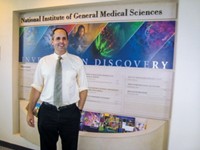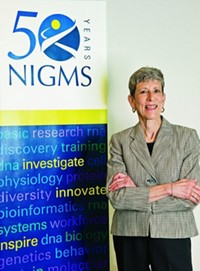Advertisement
Grab your lab coat. Let's get started
Welcome!
Welcome!
Create an account below to get 6 C&EN articles per month, receive newsletters and more - all free.
It seems this is your first time logging in online. Please enter the following information to continue.
As an ACS member you automatically get access to this site. All we need is few more details to create your reading experience.
Not you? Sign in with a different account.
Not you? Sign in with a different account.
ERROR 1
ERROR 1
ERROR 2
ERROR 2
ERROR 2
ERROR 2
ERROR 2
Password and Confirm password must match.
If you have an ACS member number, please enter it here so we can link this account to your membership. (optional)
ERROR 2
ACS values your privacy. By submitting your information, you are gaining access to C&EN and subscribing to our weekly newsletter. We use the information you provide to make your reading experience better, and we will never sell your data to third party members.
People
FASEB At 100
Federation of scientific societies evolves into a leading advocate for biomedical researchers
by Britt E. Erickson
February 6, 2012
| A version of this story appeared in
Volume 90, Issue 6
Best known for providing a voice for the working scientist and better training and working conditions for early-career researchers, the Federation of American Societies for Experimental Biology (FASEB) is celebrating its 100th anniversary this year. Founded on New Year’s Eve of 1912 during an informal gathering at the Colonial Hotel in Cleveland, FASEB has grown from representing three biological societies to advocating for 26 of them.
Advocacy has always been a part of FASEB. At the federation’s first executive meeting in 1913, officials signed a formal declaration supporting the right to perform animal experimentation. Today, the group pushes for sustained increases in federal support for basic research, elimination of overzealous security proposals, alleviation of visa restrictions, and the use of human embryonic stem cells in research. It also fights against those who want to end animal experimentation.
But advocacy has not always been the primary role of FASEB. For most of its history, the federation was largely known for its annual meeting, called the FASEB meeting. One of the reasons FASEB was created was to make it easier for its three founding societies—the American Physiological Society, American Society of Biological Chemists, and American Society for Pharmacology & Experimental Therapeutics—to hold their annual gatherings together at the same time.
“The whole organization was focused around having this one annual meeting,” FASEB Executive Director Guy Fogleman says. “It got to be quite large, well over 20,000 attendees in the 1960s,” he notes. FASEB still manages an annual meeting, although beginning in 1993, the name of the event was changed to the Experimental Biology meeting and member societies took ownership of it.
The proceedings of the FASEB meeting were published as the Federation Proceedings until the launch of the FASEB Journal in 1987. The FASEB Journal has since evolved into a relatively high impact factor journal, known for its interdisciplinary coverage of the biological field. In 2009, the monthly publication was named one of the top 100 biology journals of the past 100 years by the Special Libraries Association.
FASEB also has a long history of providing services to scientific societies. In the mid-1960s, FASEB had six member societies, all of which had moved their headquarters to the federation’s 11-acre Beaumont campus in Bethesda, Md. FASEB had purchased the estate in 1954. Once the member societies were located in one place, FASEB took on the role of providing services to them. “It made sense for the societies to share services such as membership, accounting, and later on IT,” Fogleman says.
FASEB still provides services to various societies, publishes a journal, and holds scientific conferences. But its primary role today is advocacy. “We are the voice of the biomedical researcher,” Fogleman says. “We are known for advocacy within the Administration and on the Hill.”
FASEB’s first public affairs office opened in 1968. But the shift in the organization’s focus from administration to advocacy occurred after a retreat in Williamsburg, Va., in 1989, says Howard H. Garrison, deputy executive director for policy and director of FASEB’s Office of Public Affairs. In the late 1980s, Garrison recalls, for the first time in many years, there were periods of lean funding for the National Institutes of Health. “People’s attention began to focus on the relationship between the federal government and progress in science,” he says.
At the Williamsburg retreat, “the whole nature of this federation was redesigned,” Garrison tells C&EN. A major two-part change took place: Much of the federation’s power was transferred to the societies, and FASEB began focusing its efforts on public affairs, such as advocacy for basic research. “Once that change was made, FASEB grew dramatically from representing six societies in 1989 to 26 today,” Garrison notes.
FASEB is well-known for playing a major role in persuading Congress to boost the NIH budget from $13 billion in 1998 to nearly $27 billion in 2003. “In 1995, Congress was on a course to cut the NIH budget by 5–10%—an alarming, unprecedented move,” Leon E. Rosenberg, former chief scientific officer of Bristol-Myers Squibb, wrote on a blog devoted to FASEB’s centennial. Rosenberg recalled a 1995 meeting at which he and FASEB officials tried to convince then-Speaker of the House Newt Gingrich (R-Ga.) not to reduce funding for NIH.
The meeting was a success. In early 1996, Congress approved a nearly 6% boost for NIH, the first in a series of increases. “I’m grateful that FASEB’s wise leadership and dedicated advocacy put us in the right room at a crucial moment,” Rosenberg wrote.
FASEB views its centennial as an opportunity to reenergize the scientific community and get its member societies more involved in public affairs, Garrison says. “We are using it as a chance to mobilize scientists, to bring more people to Washington to advocate for research, and more than ever, to take the message from Washington back to their local communities,” he says.
The federation has planned several events to celebrate its 100th anniversary. In May, FASEB plans to hold a reception on Capitol Hill in conjunction with NIH’s National Institute of General Medical Sciences, which this year is celebrating its 50th anniversary. NIGMS supports basic biomedical research and more chemistry-related research than any other NIH institute or center.
Another event is planned to coincide with the 50th anniversary of the completion of FASEB’s first major office building. Officials had put a time capsule in a cornerstone when the building was constructed in 1962, the 50th anniversary of FASEB’s founding. They plan to open the capsule at a ceremony this fall and reveal its historic contents. FASEB is asking its member societies and sponsors to contribute items to put in the time capsule, which they will reseal. The organization hasn’t decided where it will store the capsule for the next 50 years, Fogleman says.
FASEB is also planning a re-creation of the signing of the agreement among the three founding societies on Dec. 31 this year in the former Colonial Hotel in Cleveland, says FASEB President Joseph C. LaManna, a professor of physiology and biophysics at Case Western Reserve University School of Medicine. “I’m hoping the hotel will put up a plaque to recognize 100 years of FASEB and the signing of the document on New Year’s Eve,” he says. The hotel is now a Residence Inn owned by Marriott.
After 100 years, FASEB has evolved from an administrative organization focused on bringing scientists together for an annual meeting to an advocate for biomedical researchers. “We have a reputation now as the voice of biomedical scientists,” says FASEB President-Elect Judith S. Bond, professor and chair of biochemistry and molecular biology at Penn State. “We are called upon by Congress and by NIH and other funding agencies for data and opinions,” she says, adding that FASEB is proud to be involved in “the decision-making for the future.”
“Scientists are dedicated, very busy people who simply do not have the time individually to advocate for important matters even when they believe fervently in them,” says FASEB’s immediate past-president William T. Talman, vice chair for basic research and a professor of neurology and neuroscience at the University of Iowa. “FASEB stands ready to serve as their advocate, to promote their involvement when that involvement can be most effective, and to identify new challenges and new issues as they arise so that the community is current with the range of opportunities or threats that face it.”




Join the conversation
Contact the reporter
Submit a Letter to the Editor for publication
Engage with us on Twitter